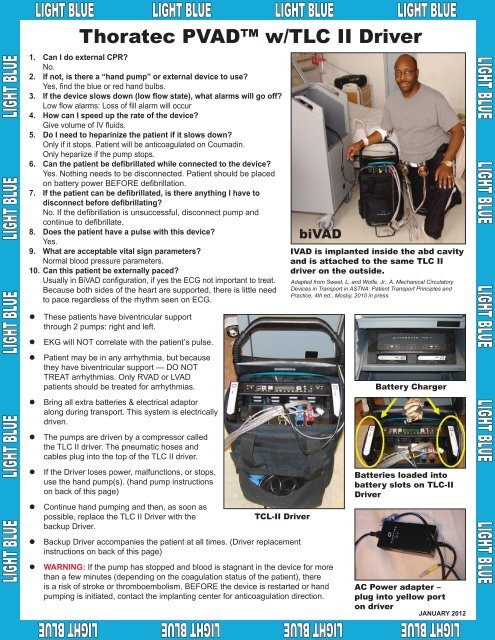EMS Guide - LVAD - MyLVAD
EMS Guide - LVAD - MyLVAD
EMS Guide - LVAD - MyLVAD
Create successful ePaper yourself
Turn your PDF publications into a flip-book with our unique Google optimized e-Paper software.
LIGHT BLUE LIGHT BLUE LIGHT BLUE LIGHT BLUE LIGHT BLUE<br />
LIGHT BLUE LIGHT BLUE LIGHT BLUE LIGHT BLUE<br />
Thoratec PVAD w/TLC II Driver<br />
1. Can I do external CPR?<br />
No.<br />
2. If not, is there a “hand pump” or external device to use?<br />
Yes, find the blue or red hand bulbs.<br />
3. If the device slows down (low flow state), what alarms will go off?<br />
Low flow alarms: Loss of fill alarm will occur<br />
4. How can I speed up the rate of the device?<br />
Give volume of IV fluids.<br />
5. Do I need to heparinize the patient if it slows down?<br />
Only if it stops. Patient will be anticoagulated on Coumadin.<br />
Only hepariize if the pump stops.<br />
6. Can the patient be defibrillated while connected to the device?<br />
Yes. Nothing needs to be disconnected. Patient should be placed<br />
on battery power BEFORE defibrillation.<br />
7. If the patient can be defibrillated, is there anything I have to<br />
disconnect before defibrillating?<br />
No. If the defibrillation is unsuccessful, disconnect pump and<br />
continue to defibrillate.<br />
8. Does the patient have a pulse with this device?<br />
Yes.<br />
9. What are acceptable vital sign parameters?<br />
Normal blood pressure parameters.<br />
10. Can this patient be externally paced?<br />
Usually in BiVAD configuration, if yes the ECG not important to treat.<br />
Because both sides of the heart are supported, there is little need<br />
to pace regardless of the rhythm seen on ECG.<br />
l These patients have biventricular support<br />
through 2 pumps: right and left.<br />
l EKG will NOT correlate with the patient’s pulse.<br />
l Patient may be in any arrhythmia, but because<br />
they have biventricular support — DO NOT<br />
TREAT arrhythmias. Only RVAD or <strong>LVAD</strong><br />
patients should be treated for arrhythmias.<br />
l Bring all extra batteries & electrical adaptor<br />
along during transport. This system is electrically<br />
driven.<br />
l The pumps are driven by a compressor called<br />
the TLC II driver. The pneumatic hoses and<br />
cables plug into the top of the TLC II driver.<br />
l If the Driver loses power, malfunctions, or stops,<br />
use the hand pump(s). (hand pump instructions<br />
on back of this page)<br />
l Continue hand pumping and then, as soon as<br />
possible, replace the TLC II Driver with the<br />
backup Driver.<br />
TCL-II Driver<br />
l Backup Driver accompanies the patient at all times. (Driver replacement<br />
instructions on back of this page)<br />
biVAD<br />
l WARNING: If the pump has stopped and blood is stagnant in the device for more<br />
than a few minutes (depending on the coagulation status of the patient), there<br />
is a risk of stroke or thromboembolism. BEFORE the device is restarted or hand<br />
pumping is initiated, contact the implanting center for anticoagulation direction.<br />
IVAD is implanted inside the abd cavity<br />
and is attached to the same TLC II<br />
driver on the outside.<br />
Adapted from Sweet, L. and Wolfe, Jr., A. Mechanical Circulatory<br />
Devices in Transport in ASTNA: Patient Transport Principles and<br />
Practice, 4th ed., Mosby, 2010 in press.<br />
Battery Charger<br />
Batteries loaded into<br />
battery slots on TLC-II<br />
Driver<br />
AC Power adapter –<br />
plug into yellow port<br />
on driver<br />
JANUARY 2012<br />
LIGHT BLUE LIGHT BLUE LIGHT BLUE LIGHT BLUE<br />
LIGHT BLUE LIGHT BLUE LIGHT BLUE LIGHT BLUE LIGHT BLUE


